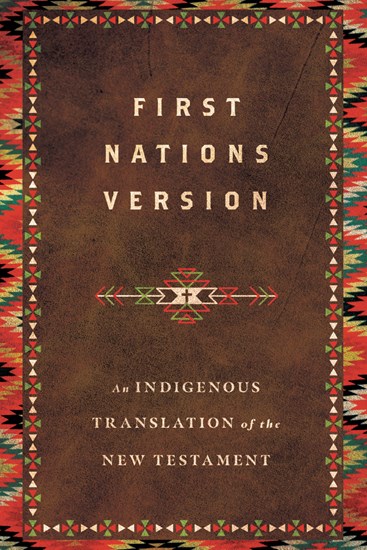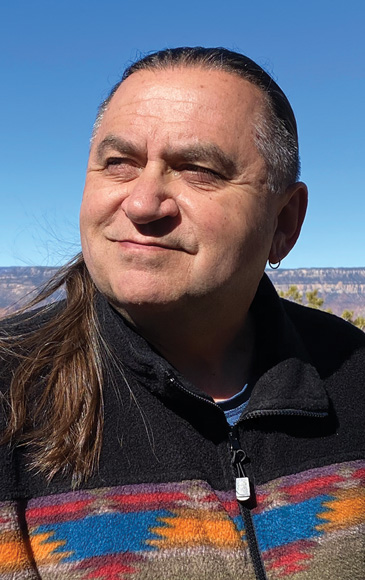First Nations Version: An Indigenous Translation of the New Testament
 First Nations Version: An Indigenous Translation of the New Testament (Downers Grove, IL: InterVarsity Press, 2021), xviii + 483 pages, ISBN 9780830813599.
First Nations Version: An Indigenous Translation of the New Testament (Downers Grove, IL: InterVarsity Press, 2021), xviii + 483 pages, ISBN 9780830813599.
The First Nations Version[1] is “An indigenous Translation of the New Testament” that provides an Introduction ([ix]-xiii), including “Why the Name First Nations Version?” (x), “Partnering Organizations,” “Church Engagement,” “The Translation Council” (x-xi), “Other Native People Involved” (xi), “Consultants and Support” (xi-xii), “Community Checking and Feedback” (xii), “Reader Aids” (xii-xiii). These are followed by a “Prologue” that gives an overview of the Old Testament, including introductory sample translations from Genesis, Jeremiah, Isaiah, and Daniel ([xv]-xviii).
Throughout the New Testament text, commentary or explanatory notes are inserted and indicated by a left-justified grey vertical bar to the left of each note. For example, “Spear of Great Waters (Pilate) was the local governor representing the People of Iron (Romans). He had the power to decide who would live and who would die.” This note explains to whom Creator Sets Free (Jesus) was taken by “the tribal elders, the scroll keepers, and the Grand Council” (Mark 15:1b). Also, throughout the FNV footnotes are supplied that include Literal translations (e.g., 1 Corinthians 14:22) and Old Testament references for 1 Corinthians 15:3 and 4). Further, “To Help The Reader with the historical and cultural context” [2] A “Glossary of Biblical Terms” is supplied. For additional information one is invited to visit: www.firstnationsversion.com and www.facebook.com/firstnationsversion.[3]

[From InterVarsity Press] Terry M. Wildman (Ojibwe and Yaqui) is the lead translator, general editor, and project manager of the First Nations Version. He serves as the director of spiritual growth and leadership development for Native InterVarsity. He is also the founder of Rain Ministries and has previously served as a pastor and worship leader. He and his wife, Darlene, live in Arizona.
The Translation Council “was selected from a cross-section of Native North Americans. Elders, pastors, young adults, and men and women from different tribes and diverse geographic locations were chosen to sit on the council” (x-xi). Also, “to minimize bias” the Council included “a diversity of church and denominational traditions” (xi). The “Translation Council humbly submits this new translation of the Sacred Scriptures as our gift to all English-speaking First Nations people and to the entire sacred family, which is the body of the Chosen One” (ix). This translation “is not a word-for-word” rendering, “but rather … a thought-for-thought translation, sometimes referred to as dynamic equivalence” (ix).
Now let us examine a few samples from the First Nation Version and other translations.
The Lord’s Prayer
9 Pray then like this:
“Our Father in heaven,
hallowed be your name.[a]
10 Your kingdom come,
your will be done,[b]
on earth as it is in heaven.
11 Give us this day our daily bread,[c]
12 and forgive us our debts,
as we also have forgiven our debtors.
13 And lead us not into temptation,
but deliver us from evil[d]” (Matt. 6:9-13 ESV. [See linked footnotes for additional translation notes]).
The Way to Pray
“9 … when you send your voice to the Great Spirit, here is how you should pray:
‘O Great Spirit, our Father from above, we honor your name as sacred and holy. 10 Bring your good road to us, where the beauty of your ways in the spirit-world above is reflected in the earth below.
11 “Provide for us day by day—the elk, the buffalo, and the salmon. The corn, the squash, and the wild rice. All the things we need for each day.
12 “Release us from the things we have done wrong, in the same way we release others for the things they have done wrong to us.
13 “Guide us away from the things that tempt us to stray from your good road, and set us free from the evil one and his worthless ways. Aho! May it be so (Matt. 6:9-13 FNV)!
“Our Father in heaven” (Matt. 6:9a ESV) is translated in the First Nations Version as “O Great Spirit, our Father from above.” Besides, “Great Spirit,” other names for God are used in the FNV, such as “… Creator, Great Mystery, Maker of Life, Giver of Breath, One Above Us All, and Most Holy One” (xiii).
For many White North Americans, their staple food is bread. But for Indigenous North Americans traditional basic foods include “the elk, the buffalo, and the salmon. The corn, the squash, and the wild rice” (6:11b-c FNV). Such a rendering of this portion in Matthew 6:11 illustrates an example of the “dynamic equivalence” (ix) principle in operation. Bannock is “a type of bread made with wheat flour, shaped into round, flat cakes and fried or baked” and that was used “(originally in indigenous Canadian cooking).”[4] So, bannock is another staple or basic food that might be considered in Matthew 6:11 (FNV).
Compare:
“Behold, I stand at the door and knock. If anyone hears my voice and opens the door, I will come in to [sic] him and eat with him, and he with me” (Rev. 3:20 ESV).
“I stand before the entrance of your tipi, asking you to welcome me in, I will sit down with you, and we will share a good meal together” (Rev. 3:20 FNV).
The First Nations Version: An Indigenous Translation of the New Testament is highly recommended for anyone, especially those serious about communicating and understanding First Nations and Indigenous people.
Kudos to everyone involved in producing this unique “dynamic equivalence” translation of the New Testament! To anyone—especially a non-Indigenous person—who takes seriously one’s need to understand and communicate better to First Nations or Indigenous people in North America, the reviewer highly recommends utilizing the First Nations Version of the New Testament.
PR
Publisher’s page: https://www.ivpress.com/first-nations-version
Dedicated page: https://firstnationsversion.com/book/first-nations-version/
Read an interview with the FNV editor, “Terry Wildman on the Making of First Nations Version, a New Indigenous Bible Translation.”
Notes
[1] First Nations Version: An Indigenous Translation of the New Testament. Downers Grove, IL: InterVarsity Press, 2021.
[2] Op. cit., [475]
[3] Op. cit., [485]
[4] Dictionary Definitions from Oxford Languages (Accessed: Nov. 17, 2022).
[5] Dictionary Definitions from Oxford Languages (Accessed: Nov. 19, 2022).
Category: Biblical Studies, Winter 2023


